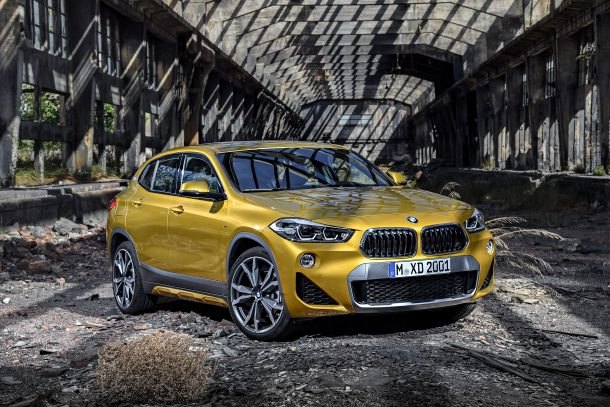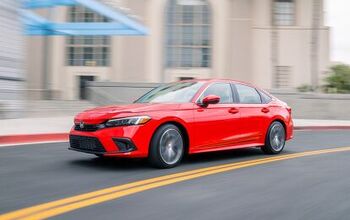BMW's X2 Is Ready to Plumb the Bottomless Crossover Market

Having just five utility vehicles in a brand’s model lineup just doesn’t cut it anymore. This isn’t 2015. If recent sales sheets have shown us anything, it’s that buyers the world over would take up arms and fight a war just for a little more choice at the crossover buffet.
Well, BMW is heeding that call. The Bavarian automaker unveiled a long-missing model this week that plugs a glaring gap at the bottom of its utility lineup — the X2.
Sharing a platform with the X1, the slightly shorter (by 3.2 inches) and lower (by 2.8 inches) 2018 X2 adds the visual brawn its sensible sibling lacks while not going too crazy with its shape. Featuring a relatively upright hatch for useable (50.1 cubic feet) cargo volume, the X2 dials up the visual aggression with lower body and wheel arch cladding, much more sculpted kidney grille openings, and a lower front fascia with gaping side vents. Lighting is LEDs all around.
As the greenhouse ends at the C-Pillar, BMW has taken the annoying route of calling the X2 a “Sports Activity Coupe,” much like its far more rakish X4 and X6 models. Anything but a crossover (which is what this is).
Many of the styling cues seen on last year’s Concept X2 carry over here, albeit in a more subdued manner. BMW makes it clear that the new model’s purpose is to add some excitement to a well-established and often boring X family, offering an M Sport X package on the X2 for those looking to increase their heart rate and the MSRP. Yes, there’ll be a BMW X2 M Sport X for you letter lovers.
Like most crossovers Sports Activity Coupes, the X2’s xDrive all-wheel-drive system channels motive power to the rear wheels when commanded, constantly monitoring the power split between front and rear. Hill Descent Control mitigates steel descents over rough terrain for those mornings when you need to slip into the work parking lot the back way.
To offset the X2’s ground clearance and utilitarian nature, buyers can option the vehicle with Dynamic Damper Control, which allows for a 0.4-inch reduction in ride height. This comes standard on stiffer M Sport variants, along with upgraded anti-roll bar bearings.
At launch, the first X2s to arrive in America next spring will carry an xDrive28i badge. You’ll find a turbocharged 2.0-liter four-cylinder under the hood, making 228 horsepower and 258 lb-ft of torque, with an eight-speed Steptronic automatic serving as the only available transmission. If there’s an M badge present, the X2 gains a quicker-shifting eight-speed variant with sport paddles. Stock variant should be capable of scooting to 60 miles per hour in 6.3 seconds.
Cocooning the X2 in safety requires checking the box for BMW’s available Driving Assistance Package, which brings all the usual aids into the fold; among them, city braking with pedestrian detection and smart cruise control. If you’re really into playing second fiddle to your car, the optional Parking Assistant will finesse that X2 into a parallel parking spot for you.
While there’s no price list for the X2 just yet, base models will make do with 18-inch wheels and non-metallic paint options for buyers willing to live with a color that isn’t Galvanic Gold.
Is the X2 simply too much X? Can customers be too spoiled for choice? What’s the saturation point for crossovers? We’ll have to wait to answer to those questions. Meanwhile, the X2 isn’t the only new crossover bound for BMW’s lineup. A larger, range-topping (and potentially terrifying) X7 looms.
[Images: BMW Group]

More by Steph Willems
Latest Car Reviews
Read moreLatest Product Reviews
Read moreRecent Comments
- Kjhkjlhkjhkljh kljhjkhjklhkjh A prelude is a bad idea. There is already Acura with all the weird sport trims. This will not make back it's R&D money.
- Analoggrotto I don't see a red car here, how blazing stupid are you people?
- Redapple2 Love the wheels
- Redapple2 Good luck to them. They used to make great cars. 510. 240Z, Sentra SE-R. Maxima. Frontier.
- Joe65688619 Under Ghosn they went through the same short-term bottom-line thinking that GM did in the 80s/90s, and they have not recovered say, to their heyday in the 50s and 60s in terms of market share and innovation. Poor design decisions (a CVT in their front-wheel drive "4-Door Sports Car", model overlap in a poorly performing segment (they never needed the Altima AND the Maxima...what they needed was one vehicle with different drivetrain, including hybrid, to compete with the Accord/Camry, and decontenting their vehicles: My 2012 QX56 (I know, not a Nissan, but the same holds for the Armada) had power rear windows in the cargo area that could vent, a glass hatch on the back door that could be opened separate from the whole liftgate (in such a tall vehicle, kinda essential if you have it in a garage and want to load the trunk without having to open the garage door to make room for the lift gate), a nice driver's side folding armrest, and a few other quality-of-life details absent from my 2018 QX80. In a competitive market this attention to detai is can be the differentiator that sell cars. Now they are caught in the middle of the market, competing more with Hyundai and Kia and selling discounted vehicles near the same price points, but losing money on them. They invested also invested a lot in niche platforms. The Leaf was one of the first full EVs, but never really evolved. They misjudged the market - luxury EVs are selling, small budget models not so much. Variable compression engines offering little in terms of real-world power or tech, let a lot of complexity that is leading to higher failure rates. Aside from the Z and GT-R (low volume models), not much forced induction (whether your a fan or not, look at what Honda did with the CR-V and Acura RDX - same chassis, slap a turbo on it, make it nicer inside, and now you can sell it as a semi-premium brand with higher markup). That said, I do believe they retain the technical and engineering capability to do far better. About time management realized they need to make smarter investments and understand their markets better.





































Comments
Join the conversation
Look at cars right up until the 1950s. Everybody hates CUVs but I think it is just the car returning to it's earlier form. Back then you had more ground clearance because roads were terrible. Nowadays, roads are terrible. Yes if you opt for the 50 series tires this is negated but I was surprised to see my wife's Santa Fe come with a 65 series tire that is very close to tires on my F150. There isn't some grand conspiracy. People like these vehicles so they buy them. They don't (in the US anyway) like hatchbacks. Especially modern hatches with such sloped rears that negate most of the advantages of a hatch in the first place.
I don't mind it. I just wouldn't actually buy it.